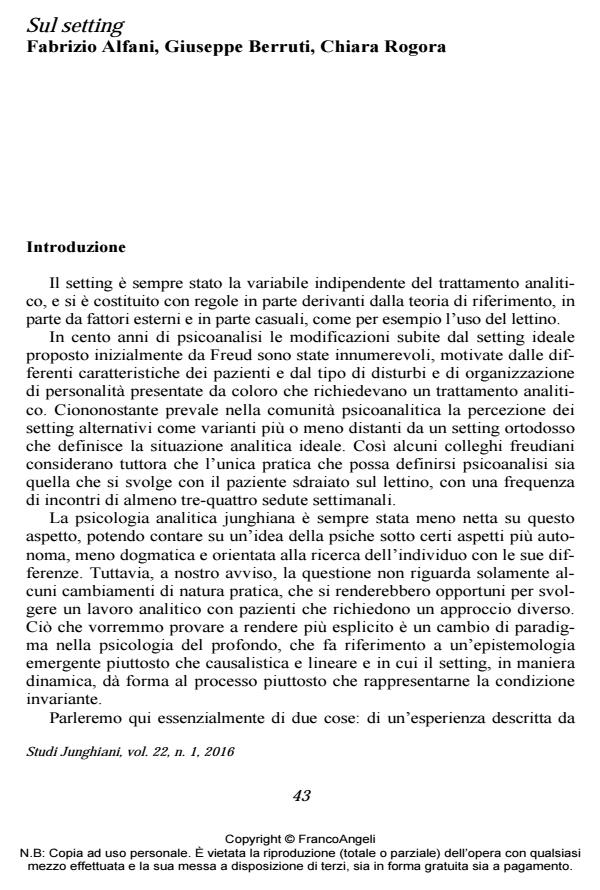On setting
Journal title STUDI JUNGHIANI
Author/s Fabrizio Alfani, Giuseppe Berruti, Chiara Rogora
Publishing Year 2016 Issue 2016/43 Language Italian
Pages 19 P. 43-61 File size 206 KB
DOI 10.3280/JUN2016-043003
DOI is like a bar code for intellectual property: to have more infomation
click here
Below, you can see the article first page
If you want to buy this article in PDF format, you can do it, following the instructions to buy download credits

FrancoAngeli is member of Publishers International Linking Association, Inc (PILA), a not-for-profit association which run the CrossRef service enabling links to and from online scholarly content.
The Authors propose some reflections on the setting, considering it a relational device, which can assume different forms and take place in various contexts. Starting with three short clinical vignettes, they highlight how analytical work is proposed today in contexts that are very different from the traditional consulting room. Referring to playing and theatrical performance, they underline that one of the peculiar characteristics of the setting is its capacity to define a space and a time within which the analytic pair may experience a vital ambiguity (Racamier) and a sense of play (Winnicott), within an analytical process considered from the point of view of an a-causal emerging epistemology.
Keywords: Setting, analytical relationship, emergentism, ambiguity, play, meeting moments
- Aite P., Galeazzi P. (2015). Gioco è realtà. Rivista di Psicologia Analitica. Nuova serie n. 40, vol. 92: 275.
- Boston Change Process Study Group (BCPSG) (2010). Change in psychotherapy. New York, London: Norton (trad. it. Il cambiamento in psicoterapia. Milano: Cortina, 2012).
- Buber M. (1923). Ich und Du. Berlin: Shocken Verlag (trad. it. Il principio dialogico e altri saggi. Cinisello Balsamo: San Paolo, 1993).
- Cahn R. (2002). La fin du divan? Paris: Jacobe (trad. it. La fine del divano? Roma: Borla, 2004).
- Cambray J., Carter L. (2004). Analytical Psychology. Hove, East Sussex; New York: Brunner-Routledge (trad. it. Psicologia Analitica. Roma: Fioriti, 2010).
- Cassidy J., Shaver Ph.R., eds. (2008). Handbook of Attachment. New York: Guilford Press (trad. it. Manuale dell’Attaccamento. Roma: Fioriti, 2010).
- Crowther C., Schmidt M. (2015). States of grace: Eureka moments and the recognition of the unthought known. Journal of Analytical Psychology, 60, 1: 54-74. DOI 10.1111/1468-5922.12129
- Hogenson G.B. (2004). L’emergenza e la struttura profonda della psiche. Psicologia Analitica, nuova serie, 18: 44-56.
- Knox J. (2003). Archetype, attachment, analysis. London: Routledge (trad. it. Archetipo, Attac ca mento, Analisi. La psicologia junghiana e la mente emergente. Roma: Magi, 2007).
- Jung C.G. (1916/1958). Die transzendente Funktion (trad. it. La funzione trascendente. In: Opere, vol. 8. Torino: Boringhieri, 1976).
- Jung C.G. (1921). Psycologische Typen (trad. it. Tipi Psicologi. In: Opere, vol. 6. Torino: Boringhieri, 1969).
- Jung C.G. (1935). Fundamental Psychological Conceptions: A Report of Five Lectures (trad. it. Fondamenti della psicologia analitica. Quinta conferenza. In: Opere, vol. 15. Torino: Boringhieri, 1991).
- Racamier P.C. (1970). Le psychanalyste sans divan. Paris: Payot (trad. it. Lo psicoanalista senza divano. Milano: Cortina, 1982).
- Racamier P.C. (1992). Le génie des origines. Paris: Payot (trad. it. Il genio delle origini. Milano: Cortina, 1993).
- Rovelli C. (2014). Sette brevi lezioni di fisica. Milano: Adelphi.
- Schore A.N. (2003). Affect Regulation and the Repair of the Self. New York: Norton (trad. it. La regolazione degli affetti e la riparazione del Sé. Roma: Astrolabio, 2008).
- Stern D.N. (2004). The Present Moment in Psychotherapy and in Everyday Life. New York: Norton (trad. it. Il momento presente in psicoterapia e nella vita quotidiana. Milano: Cortina, 2005).
- Strumia F. (2014). Note sulla terapia online. Psicobiettivo, 3: 51-65. DOI 10.3280/ PSOB2014-003004
- Wiener J. (2015). The analytic setting today: using the couch or the chair? Journal of Analytical Psychology, 60, 4: 462-476. DOI 10.1111/1468-5922.12164
- Winnicott D.W. (1971). Playing and Reality. London: Routledge (trad. it. Gioco e realtà. Roma: Armando, 1995).
- Setting e processi dissociativi Gianluigi Di Cesare, Fabrizio Alfani, in STUDI JUNGHIANI 47/2018 pp.47
DOI: 10.3280/JUN2018-047004 - L'esperienza analitica e la realtà virtuale Fabrizio Alfani, in STUDI JUNGHIANI 58/2024 pp.22
DOI: 10.3280/jun58-2023oa16433
Fabrizio Alfani, Giuseppe Berruti, Chiara Rogora, Sul setting in "STUDI JUNGHIANI" 43/2016, pp 43-61, DOI: 10.3280/JUN2016-043003